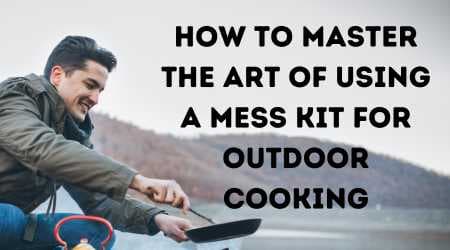To use a mess kit, first organize the utensils and assemble the kit, then use the cookware to prepare meals and clean it thoroughly afterwards. A mess kit is a portable container that holds cooking and eating utensils for outdoor activities such as camping, hiking, and backpacking.

It usually includes a pot, pan, plate, cup, and utensils such as a spoon, fork, and knife, all designed to compactly fit together for easy transportation. Knowing how to use a mess kit is essential when spending time in nature, as it allows for meal preparation and efficient cleaning. In this article, we will discuss the different types of mess kit, tips for packing and organizing your kit, as well as instructions for using it to cook and clean up after your meal.
Understanding The Basics Of Mess Kit
Mess kits are a staple for backpackers, hikers, and anyone who loves outdoor adventures. these kits are designed to make meal preparation and eating easier when you're away from your usual kitchen equipment. in this article, we will explore the basics of mess kits and all you need to know to use one effectively.
What Is A Mess Kit?
A mess kit is a compact and lightweight set of cooking and eating equipment. it usually includes a pot or pan, a lid that can be used as a plate, utensils, and sometimes cups. mess kits are often made from durable materials such as aluminum, stainless steel, or titanium, that are easy to clean and can withstand the rigors of outdoor life.
Different Types Of Mess Kits
There are several types of mess kits to choose from, each with its own unique features and benefits. here are some of the most common types:
- Basic mess kits: these are simple and affordable kits that usually come with a pot, pan, and a single plate/bowl combo, along with a utensil set. they're perfect for camping trips where you need to cook basic meals for one or two people.
- Deluxe mess kits: these kits often include more pieces, such as a dedicated bowl, cup, and additional utensils. they may have non-stick coatings, and sometimes come with a carrying case for easy transport.
- Modular mess kits: these kits allow you to customize your cooking setup by combining different pieces that can be used interchangeably. you can mix and match pots, pans, and utensils to create a mess kit that suits your specific needs.
- Ultralight mess kits: these are designed for backpackers and hikers who need to minimize weight and bulk in their pack. ultralight mess kits are made from materials such as titanium that are incredibly lightweight and durable. they often include just the essentials, such as a pot, cup, and utensil set.
Mess kits are an essential piece of gear for anyone who loves the outdoors. by choosing the right kit for your needs, you can make meal preparation and eating a breeze, no matter where your adventures take you.
Preparing Your Mess Kit
It's time to hit the trails and enjoy the great outdoors! but before you go, you'll need to learn how to prepare your mess kit. proper preparation is crucial to ensuring your meals are delicious and safe to consume. in this section, we'll cover the importance of assembling, cleaning, sanitizing, and packing your mess kit.
Assembling The Mess Kit
Before heading out, you'll need to assemble your mess kit. a mess kit typically includes a pot, pan, bowl, cup, utensils, and a storage bag. once you have all of your materials, follow these steps to assemble your mess kit:
- Place the pot, pan, bowl, and cup inside each other, starting with the largest item at the bottom.
- Nestle the utensils between the pot and pan, making sure everything is compact.
- Store the entire kit inside the storage bag, making sure to seal it tightly.
Cleaning And Sanitizing The Mess Kit Before Use
It's important to clean and sanitize your mess kit thoroughly before each use. here's how:
- Use hot, soapy water and a scrubber to clean each item.
- Rinse each item with clean water.
- Sanitize each item by boiling them in hot water for at least 10 minutes.
- Dry everything thoroughly before packing it away.
Packing The Mess Kit For Transport
Once your mess kit is clean and dry, you're ready to pack it for transport. here are some tips:
- Store the utensils in a separate ziplock bag to prevent them from scratching other items.
- Place the storage bag containing all items in your backpack.
- If possible, store the kit in an outside pocket for easy access.
Proper preparation is key to having a successful and enjoyable outdoor adventure. by following these simple steps, your mess kit will be clean, sanitized, and ready to use whenever you're ready to cook up a delicious meal.
Setting Up Your Cooking Station
Setting up your cooking station cooking in the great outdoors is a unique experience that can be accomplished with a mess kit. however, before you start cooking, you should prepare your cooking station. this consists of selecting an ideal location, building a fire, or using a portable stove while considering safety precautions.
Choosing A Location
Selecting the right location for your cooking station is paramount. here are some pointers to help you choose the perfect spot:
- pick a place that is level and far from your tent, trees, or flammable materials.
- avoid any areas with dry leaves, tall grass, or dead branches that could catch fire.
- make sure there is running water nearby that is safe to drink.
- avoid setting up camp close to water sources to avoid accidents and animals.
Building A Fire
If you want to have a traditional campfire and cook outdoors, you need to know how to build a safe and efficient fire. here are some steps to follow:
- clear the area of any flammable materials.
- dig a shallow pit and surround it with rocks.
- gather dry wood, kindling, and tinder.
- place the tinder in the pit and surround it with kindling.
- light the tinder and blow gently on it to help it catch fire.
- once the fire ignites, add more wood, and stack it neatly to keep the fire burning.
Using A Portable Stove
Using a portable stove is a safer and more convenient way to prepare meals in the great outdoors. here are some key things to keep in mind:
- choose a stove that suits your needs, such as small or compact stoves that are easy to carry.
- check if the stove requires a fuel source, such as gas canisters or liquid fuels.
- follow the instructions and assemble the stove in a flat and stable position.
- place the pot or pan on the stove, and adjust the flame to control the temperature.
- after cooking, let the stove and the pot or pan cool down before packing them away.
Safety Precautions
Regardless of your cooking method, it's crucial to ensure your safety and that of those around you. here are some safety tips to consider:
- keep a fire extinguisher or a bucket of water nearby in case of an emergency.
- avoid wearing loose-fitting clothing that may catch fire or move around easily.
- keep small children away from the cooking station.
- wash your hands before cooking and keep your cooking area clean.
- don't leave the cooking station unattended, especially the fire.
- dispose of ashes properly and pack out all trash.
By following these steps, you can create a cooking station that is safe, efficient, and perfect for outdoor cooking.
Cooking With Your Mess Kit
Cooking with your mess kit a mess kit is a fantastic option for outdoor enthusiasts looking to enjoy delicious meals in the wilderness. it is a portable cooking set that is ideal for camping or hiking trips. here are a few things to keep in mind when using your mess kit to prepare your next meal.
Choosing The Right Utensils
Before starting, you must choose the appropriate utensils. here are a few things to keep in mind when selecting utensils for your mess kit:
- Only choose items that are lightweight and compact
- Look for utensils that serve multiple purposes for efficient packing
- Avoid cookware made of aluminum or other harmful materials
- Always check the heat resistance of each utensil before using it
Read also : Top 10 Best Kitchen Utensil Sets of 2023 Reviews
Using Your Mess Kit To Cook Different Meals
Your mess kit can be used to prepare a wide range of delicious meals in the wilderness. some examples are:
- Pancakes, omelets, and scrambled eggs for breakfast
- Stews, soups, and chili for lunch and dinner
- Stir-fry, pasta, and rice dishes for dinner
- Grilled sandwiches, quesadillas, and burgers for lunch
Here are some tips to help you cook with your mess kit in the great outdoors:
- Use a small stove with a low flame for the best results
- Boil water in a pot before adding ingredients for faster and efficient cooking
- Try to use fresh ingredients and seasonings for maximum taste
- Always check the temperature of your food before consuming
Regulations For Cooking In The Wilderness
When cooking in the wilderness, you must adhere to some essential environmental regulations. here are a few guidelines to help you cook safely:
- Check for local regulations regarding cooking in the wilderness
- Always use established fire rings and stoves
- Minimize your impact on the environment by using biodegradable cleaning products
- Avoid cooking near water sources or other natural landmarks
- Never leave food unattended while cooking
With these tips, you'll be able to use your mess kit to cook nutritious, delicious meals while minimizing your impact on the environment. enjoy your time in the great outdoors!
Cleaning And Maintaining Your Mess Kit
Cleaning Your Mess Kit After Use
Keeping your mess kit clean after a meal is essential for its longevity and usability. here are some tips on cleaning your mess kit after use:
- Remove any leftover food or debris with a scraper or a soft-bristle brush.
- Wash your mess kit with warm water, mild soap and a sponge. avoid scrubbing too hard or using abrasive sponges that can damage the surface.
- Use a cloth or towel to dry your mess kit thoroughly before storing it.
Storing Your Mess Kit
Proper storage of your mess kit is crucial to prevent any damage or deterioration. Here are some tips on storing your mess kit:
- Store your mess kit in a clean, dry and cool location. avoid exposing it to direct sunlight or extreme temperatures.
- Place your mess kit in a carry bag or a protective sleeve to prevent scratches or dents during transport.
- Keep your mess kit away from any sharp or heavy objects that could damage it.
Inspecting And Maintaining Your Mess Kit Regularly
Regular inspections and maintenance can help identify any issues with your mess kit and prevent any further damage. Here are some tips on inspecting and maintaining your mess kit:
- Check for any signs of rust, corrosion or scratches on the surface of your mess kit. These can indicate that it needs to be repaired or replaced.
- Inspect your mess kit after each use to identify any damage or wear and tear.
- If your mess kit is made of stainless steel, use a stainless steel cleaner to maintain its shine and prevent rust or tarnish.
Troubleshooting Common Problems With Your Mess Kit
Even with proper care and maintenance, mess kits can encounter some common issues that need troubleshooting. Here are some tips on how to troubleshoot those problems:
- If your mess kit is leaking, check the seals and gaskets for any damage or wear and tear. Replace any damaged parts as soon as possible.
- If your mess kit is not heating your food or beverage properly, check the burner or fuel canister for any blockages or clogs.
- If food is sticking to your mess kit, try seasoning it with cooking oil or butter before use. Additionally, avoid using metal utensils that can scratch the surface.
By following these tips on cleaning, storing, inspecting and troubleshooting your mess kit, you can ensure its longevity and usability for all your outdoor adventures.
Tips And Tricks For Using A Mess Kit
Are you planning a camping trip soon? if so, then you should definitely invest in a mess kit! but what is a mess kit? it's a compact set of cooking and eating utensils that is easy to carry and perfect for outdoor adventures. But to make the most of your mess kit, you need to know some tips and tricks. In this post, we will cover some helpful tips for using a mess kit, including cooking without utensils, making make-ahead meals, reducing your environmental impact, and using your mess kit for activities beyond camping.
Cooking Without Utensils
In a pinch, you can cook without utensils using your mess kit. here are some cooking tips that don't require utensils:
- Wrap sweet potatoes, onions, and garlic in tin foil and throw it in the smoldering coals of your campfire until they're tender.
- Cook small pieces of meat (like chicken or sausage) on skewers over the fire.
- Use a stick to make kebabs with cubed veggies and meat.
- Cook scrambled eggs by cracking them into a plastic bag, adding cheese and other desired toppings, and then tossing the bag into a pot of boiling water.
Make-Ahead Meals
Making make-ahead meals can save you time and effort on your camping trip. here are some ideas:
- Cook rice, quinoa, or pasta, and keep it in an airtight container in your cooler. Then heat it up with some canned beans, tuna, or veggies for an easy one-pot meal.
- Make breakfast burritos by cooking scrambled eggs, adding cheese and any other desired toppings, and then wrapping it all up in a tortilla. Keep them in your cooler and reheat over the campfire.
- Cook chili or stew in advance, freeze it, then reheat and serve over rice for a hearty meal.
Reducing Your Environmental Impact
Using a mess kit is already a great way to reduce waste compared to using disposable plates and utensils. here are some additional tips for reducing your environmental impact:
- Only boil the water you need for cooking or drinking.
- Try to use biodegradable soap and cleaning supplies.
- Don't dump any food waste near your campsite. pack it in and pack it out.
- Bring a reusable water bottle instead of purchasing disposable plastic bottles.
Using Your Mess Kit For Activities Beyond Camping
Your mess kit can be handy for other activities beyond camping. here are some ideas:
- Keep one in your car for road trips so that you can eat your takeout food without using plastic utensils (or even better, use the utensils from your mess kit instead).
- Bring it with you to a picnic or a park so that you don't have to rely on flimsy paper plates and cups.
- Use it on a boat trip or a fishing excursion, where space is limited and you need to be able to cook and eat.
A mess kit is a fantastic addition to any outdoor adventure. hopefully, these tips and tricks have given you some ideas on how to make the most of your mess kit. happy camping!
Conclusion
It's always important to be prepared for outdoor adventures, and using a mess kit can make mealtime a breeze. With proper guidance on how to use a mess kit, you can easily pack and cook meals while camping or trekking. Remember to pack only what you will need, clean your mess kit after each use, and practice safe food handling practices. Don't forget to use the right cooking techniques to ensure your food is safe to eat and delicious. A mess kit is a versatile piece of equipment, and with some practice, you can use it to cook anything from eggs to stew. By following these tips, you can make your next outdoor adventure an enjoyable and hassle-free experience. Happy cooking!
Frequently Asked Questions Of How To Use A Mess Kit
1. What Is A Mess Kit And Why Should I Use One?
A mess kit is a portable set of cooking and eating utensils designed for outdoor use. It's ideal for camping, hiking, and other outdoor activities, as it's lightweight and compact. Using a mess kit can help you prepare and enjoy meals in the great outdoors without the need for bulky, heavy cookware and dishware.
2. What Are The Essential Components Of A Mess Kit?
A typical mess kit includes a pot, a frying pan or skillet, a bowl, a plate, and eating utensils such as a fork, spoon, and knife. Some mess kits may also come with accessories like a spatula or a ladle.
3. How Do I Clean A Mess Kit?
Cleaning your mess kit is essential for maintaining its longevity and keeping it in good condition. Use a sponge or cloth to wipe off any food debris, then wash it with warm soapy water. Rinse thoroughly to remove all soap residue, and dry completely before storing.
4. Can I Use A Mess Kit On A Campfire?
Yes, mess kits are usually made of durable materials like stainless steel or aluminum, which can withstand high temperatures. Just be careful not to overheat the pots and pans, and use appropriate cooking utensils to avoid scratching the surface.





